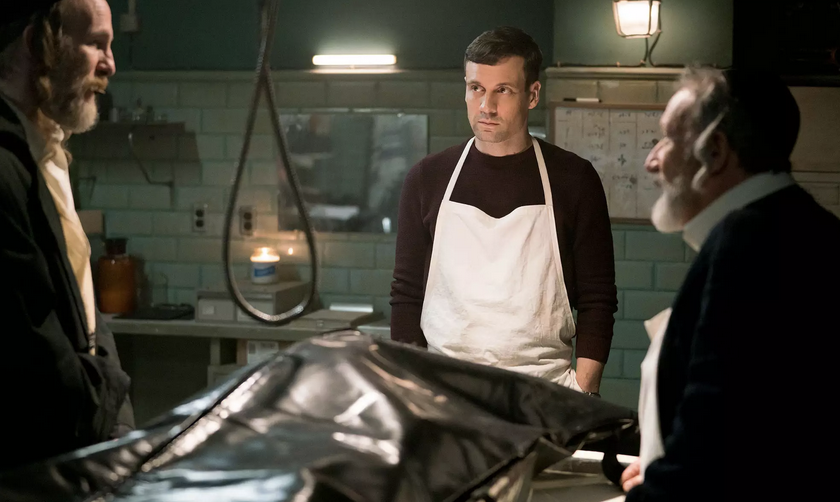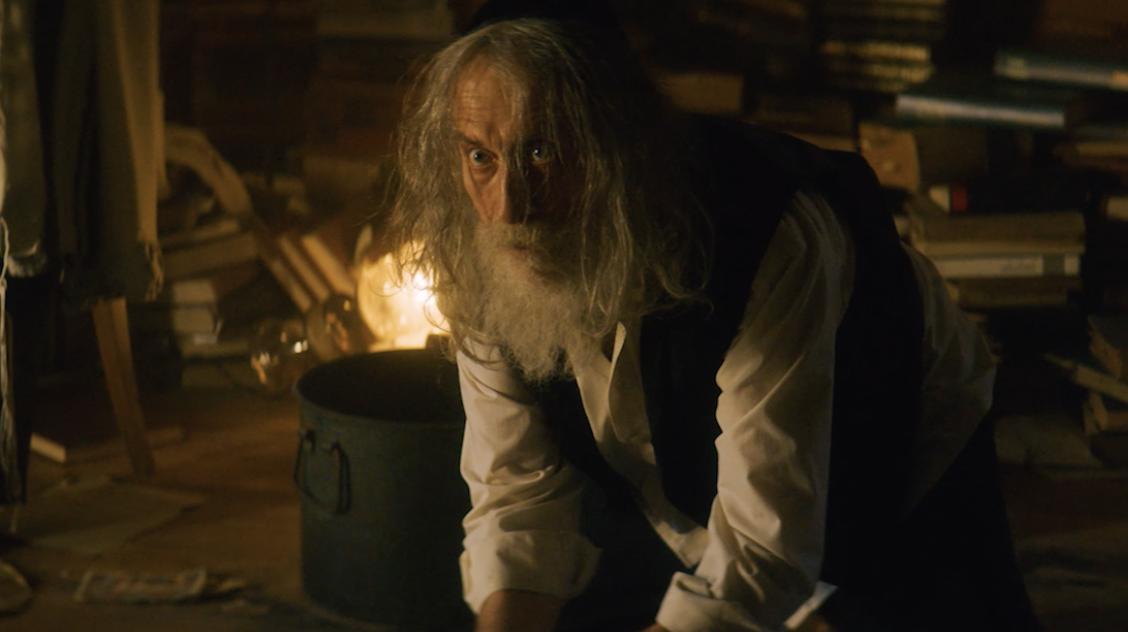A Demon Hunts in Brooklyn – The Offering
By Sue Weston and Susan Rosenbluth – Two Sues On The Aisle
The Offering, a horror movie set in a Hasidic Brooklyn community, blends mysticism with raw fear. The story is complicated, exploring relationships and connections–between husbands and wives, fathers and sons, and community and religion. It takes place in Boro Park Brooklyn, a private community in which spirituality and reality coexist, where the Kabbalah holds secrets connecting the world of the living and the dead.
By breaching this divide, the most feared of demons–Abyzou, “taker of children,”–is released into the world of the living. According to legend, this female demon does not sleep; she wanders the world looking for women about to give birth and, given the opportunity, will strangle newborns. She is ruthless, doing whatever is necessary to get what she wants. By presenting dreams within dreams, she forces her prey to see and feel things that aren’t real. Prevent her from feeding, and you just might suffer blindness, choking, deafness, madness, and death.
Directed by Oliver Park and distributed by DECAL, The Offering was released digitally and in theaters on January 13.
Twisted Plot
The movie opens in a dark dank apartment covered with symbols and papers, bathed in flickering light and shadows. Amid flashes of motion, a man with bulging eyes and wild hair slaughters a chicken and lays a circle of ashes. As a result, apparitions appear, first his wife and then a young girl with vacant eyes. He is reminded of the rule “a life for a life,” followed by Abyzou’s ominous threat: “There are always others .. you know what happens when I don’t feed.”
The film then switches to a bright Brooklyn Street where children are at play. Sitting in a car, Art (Nick Blood) is preparing to introduce his very pregnant wife, Claire (Emily Wiseman), to his Orthodox father, Saul (Allan Corduner). The camera pauses on a lamppost displaying a poster of a missing child. The couple enters the house in which Art grew up, a Brooklyn brownstone, which is also Friedmans’ Funeral Home–and a service is in progress.
It is More than a Horror Movie
The movie is complicated. A lot of it focuses on Abyzou, a she-devil who uses mind control to distort reality, and her powers are escalating. In fact, she might be destroying the funeral parlor. By adding Jewish demonology to a film riddled with ritualistic practices, the movie takes on a new dimension.
But perhaps the heart of the film is its exploration of the connections between widowers and the wives they have lost. Yossi, for example, is so desperate to reconnect with his wife, he is willing to dabble in dangerous mysticism. Saul, on the other hand, seems just to have shut down after the death of his wife. In his professional life as the director of a funeral home, Saul was able to comfort others, but personally, he was unable to move past his loss and, as a result, isolated himself from Art, his only child.
The relationship between the grieving father and son is also a focus of the film. After his mother died, Art turned his back on religion, but as the film opens, he tells Claire he hopes for a reconciliation with his father who he’s certain has “loosened his yarmulka” and will want a relationship with his future grandchild.
Indeed, grateful for the opportunity to make amends, Saul, who did not attend his son’s wedding, embraces his family and explains to Claire, “When you see the world a certain way, it’s not easy to accept change.” He expresses regret for not attending their wedding and admits he has been following Claire’s writing career. He is proud of his son’s accomplishments as a “real estate macher.”
But Art’s decision to assimilate is a point of contention with Saul’s assistant, Hamish (played by Paul Kaye, known for his roles in Game of Thrones and Tollbooth), who suspects his boss’ son has ulterior motives for returning. While Hamish relentlessly needles Art for marrying a shiksa and distancing himself from his father, Saul himself disregards his underling’s warnings and welcomes his son without reservations.

In the funeral parlor, Hamish (Paul Kaye ), Art (Nick Blood), and Saul (Allan Corduner) prepare the body
Jewish Roots
Two of the lead producers of the film, Jonathan Yunger and Hank Hoffman, credited their own Orthodox-Jewish backgrounds for playing a part in the creative process and influencing the reconciliation subtext.
“As longtime fans of the horror genre, Hank Hoffman and I dug into our Orthodox-Jewish backgrounds to craft a story that takes the audience to a rich and unfamiliar world and shows how deep the roots of Judaic mysticism can go and how colorful the exploration of the esoteric can be, all while scaring the crap out of you,” said Mr. Yunger.
In fact, the Orthodox community is portrayed respectfully in the film, an important factor since The Offering may be some viewers’ first exposure to Hasidic culture and Yiddish. This is especially true for those attracted to the movie more for its horror genre than its Jewish subtext. The film portrays a shiva house, kriah (the rending of garments by mourners), and tahara (the ritual cleansing of a dead body in preparation for burial), making these practices feel natural. Yes, of course, there were a few inaccuracies (how hard would it have been to make sure an Orthodox rabbi approved these practices before filming), but overall, it was a fair representation of Orthodox-Jewish culture.
Even the non-Jewish wife, Claire, shows respect for Orthodox practices. She covers her head for Shabbos, watching with fascination as Saul lights the candles and sings Aishes Chayil. She compliments his preparation of dumplings (kreplach) and listens with rapt attention as he explains the concepts that “connect the body to the soul.”
The Production
The movie uses all the tricks of its genre to keep the audience on edge, and, yes, we, too, found ourselves occasionally jumping from our seats. Dim lights, long shadowy hallways, mirrors, exposed lightbulbs, and squeaking doors work in combination with whispering voices and noises to set an ominous mood. The suspense builds steadily from the opening scene, leaving the viewer with an unsettled feeling of impending doom, balanced with the desire for reconciliation and a happy ending.
Mr. Hoffman said he strove to connect Jewish demonology with scary scenes taken from his own nightmares, seeking to create suspense by placing the horned, goatlike monster blamed for miscarriages and infant mortality next to Claire in the Brooklyn building. He used mirrors to trick viewers’ eyes into seeing what is not there. In the shiva house, instead of reflecting the room, the mirror (yes, of course, it should have been covered) shows people frozen while the dybbuk speaks from beyond, and in the bedroom, the mirror projects a fresh bloodstain, suggesting a future miscarriage.
Like in all good horror movies, the viewer senses the evil lurking in the house, waiting to strike, while Claire is naively unaware.
Over the course of the film, you’d have to be a supporter of the demons not to fear for Claire’s safety. The movie, bone-chillingly–and intentionally–leaves much to the imagination, showing bodies dragged across the floor followed only by sounds of struggle and carnage.
Masterfully Executed
The Offering works on many levels, intertwining new beginnings with old beliefs, set in a community whose practices are timeless. Not surprisingly, answers come from a kabbalist, who interprets the carved inscriptions on a knife. He suggests the only solution is sealing the demon into another body, cautioning that the process must be followed precisely according to protocol in order to restore order.
The casting was superb, and the setting was realistic, They made it look like Brooklyn even though it was shot thousands of miles away. The performances made this bizarre story (almost) believable. But it was the audio technology that brought it all together, creating a visceral experience that pushed past the relatable and brought the viewer into the unfathomable, transporting us to a place where anything is possible.
The film takes as its maxim the sense that humanity has the responsibility of maintaining order. To quote the kabbalist: “Only we can determine how much good or evil enters our realm.” All actions have consequences. The Offering explores the dark side of impulse, leaving us to contemplate the two words on Yossi’s typewriter: “forgive me.”
Watch The Offering and prepare to be scared.
*********
Two Sues on the Aisle bases its ratings on how many challahs (1-5) it pays to buy (rather than make) in order to see the play, show, film, or exhibit being reviewed.
The Offering received a 3 Challah Rating







